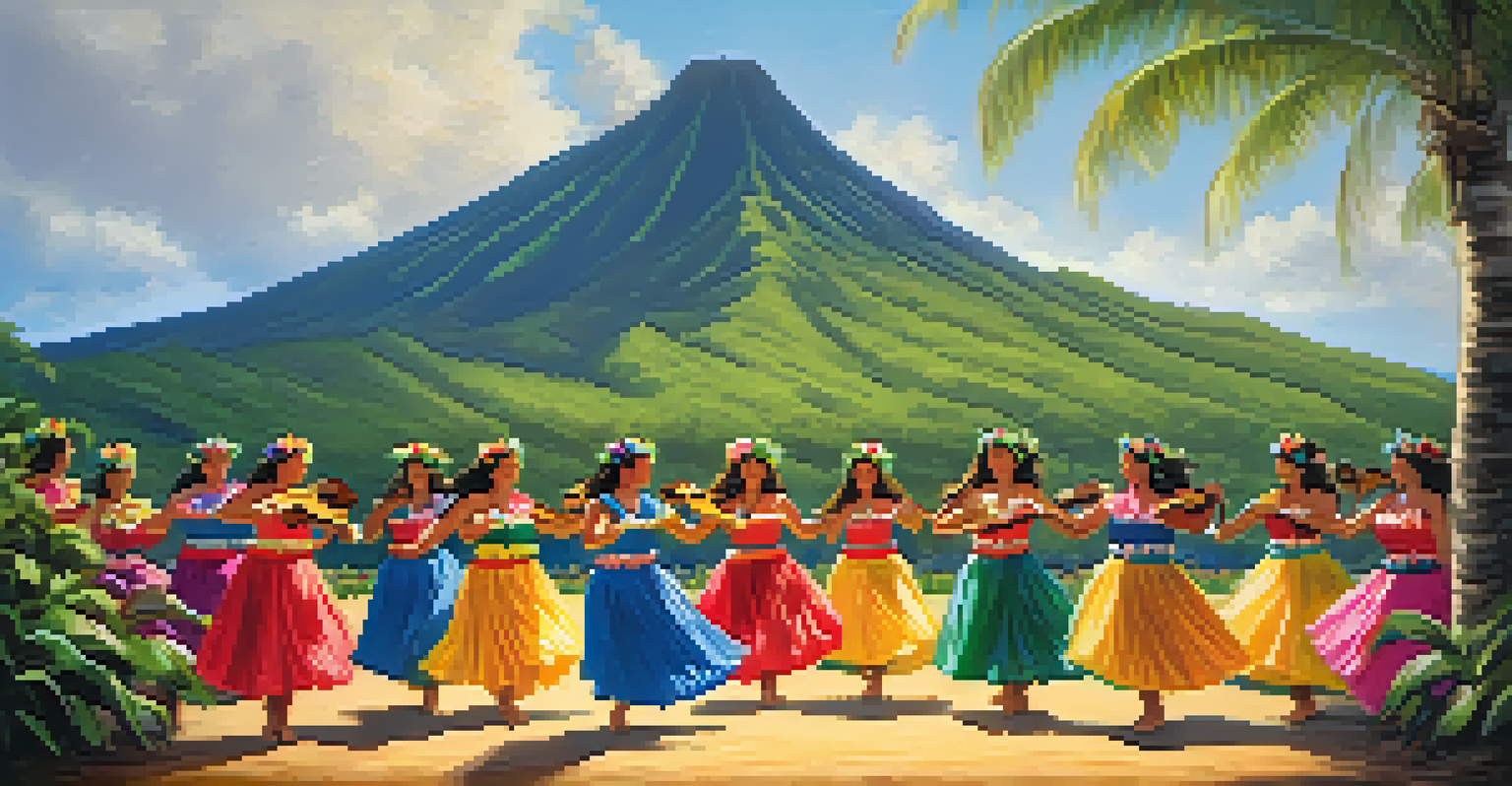Traditional Hawaiian Ukulele Styles: A Study of Variations

Understanding the Ukulele's Hawaiian Roots and Evolution
The ukulele, often associated with Hawaiian culture, has a fascinating history that dates back to the 19th century. Originally derived from the Portuguese machete, it found its way to Hawaii through immigrants, who then adapted it into something uniquely Hawaiian. This evolution not only enriched the instrument but also blended various musical traditions and styles.
The ukulele is the instrument of the people, a symbol of joy and togetherness.
As the ukulele gained popularity, it transformed into a symbol of Hawaiian music, representing the spirit of 'Aloha' and the islands' vibrant culture. This transformation involved the incorporation of local rhythms and melodies, which gave rise to distinct playing styles. Understanding these roots helps us appreciate the depth of the ukulele in Hawaiian music today.
From its humble beginnings, the ukulele has become more than just an instrument; it's a cultural icon. It serves as a bridge connecting generations of musicians and listeners, all while embodying the warmth and beauty of Hawaiian traditions. This connection to the past is vital as we explore the various styles that have emerged over time.
The Strumming Techniques That Define Hawaiian Ukulele Styles
One of the key elements that differentiate Hawaiian ukulele styles is the strumming technique. Various patterns, such as the 'slack key' or 'chord-melody' styles, create unique sounds that resonate with listeners. Each technique not only influences the music's rhythm but also adds to the emotional expression of the piece.

For instance, the traditional 'Hawaiian strum' involves a simple down-up motion that gives a gentle, flowing feel to the music. On the other hand, more intricate techniques like fingerpicking allow musicians to showcase their skills while adding depth to the melody. These contrasting methods highlight the versatility of the ukulele, making it suitable for a variety of musical genres.
Ukulele's Hawaiian Cultural Significance
The ukulele, evolving from Portuguese roots, has become a symbol of Hawaiian music and culture, embodying the spirit of 'Aloha'.
Mastering these techniques is essential for any ukulele player wishing to explore Hawaiian music. They offer a rich palette of sounds, enabling musicians to express the essence of Hawaii through their performances. As players experiment with these styles, they contribute to the ongoing evolution of Hawaiian music.
Exploring the Unique Melodies of Hawaiian Slack-Key Guitar
Slack-key guitar, known as 'ki ho'alu,' is a traditional Hawaiian style that greatly influences ukulele music. This technique involves loosening the guitar strings to create a unique tuning that produces soothing, melodic sounds. The essence of slack-key can be heard in many ukulele compositions, showcasing its importance in Hawaiian music.
Music is the language of the spirit. It opens the secret of life bringing peace, abolishing strife.
In slack-key, musicians often play beautiful fingerstyle melodies that complement the ukulele's sound. When combined, the ukulele and slack-key guitar create a harmonious blend that captures the spirit of the islands. This collaboration between instruments has led to a rich repertoire of songs that celebrate Hawaiian culture and landscape.
As you listen to slack-key music, you may notice how its relaxed and flowing nature mirrors the Hawaiian way of life. This connection between music and culture makes slack-key guitar an essential component of traditional Hawaiian music, further enriching the ukulele's repertoire and styles.
The Role of Ukulele in Traditional Hawaiian Hula Performances
Hula, the traditional Hawaiian dance, is deeply intertwined with the ukulele, as both art forms complement each other beautifully. The rhythms and melodies played on the ukulele enhance the storytelling aspect of hula, allowing dancers to express their emotions through movement. This synergy creates a captivating experience for both performers and audiences alike.
In hula performances, the ukulele often provides the rhythmic backbone, supporting the dancers' movements with its vibrant sound. Various styles of hula, such as 'auana' and 'kahiko,' showcase different ukulele techniques, highlighting the instrument's versatility. Each performance reflects the unique narrative being told, further emphasizing the close relationship between hula and the ukulele.
Diverse Strumming Techniques
Different strumming techniques like 'slack key' and fingerpicking contribute to the emotional expression and versatility of Hawaiian ukulele music.
As you immerse yourself in a hula performance, you'll notice how the ukulele elevates the entire experience. The combination of music and dance not only captivates the audience but also preserves the rich cultural heritage of Hawaii. This dynamic partnership continues to thrive, ensuring that traditional Hawaiian arts remain alive and vibrant.
The Influence of Contemporary Music on Hawaiian Ukulele Styles
As the world of music evolves, so does the traditional Hawaiian ukulele. Contemporary artists are blending modern genres, like pop and reggae, with traditional Hawaiian music, creating innovative styles that appeal to a broader audience. This fusion has not only revitalized interest in the ukulele but also introduced new techniques and sounds.
For example, musicians like Jake Shimabukuro have gained international fame by pushing the boundaries of what the ukulele can do. His unique approach combines traditional Hawaiian elements with jazz and rock influences, showcasing the instrument's versatility. This blending of styles invites new players to explore the ukulele, further expanding its reach and popularity.
The integration of contemporary music into Hawaiian ukulele styles serves as a reminder of the instrument's adaptability. By embracing change while honoring its roots, the ukulele continues to evolve, ensuring its place in the ever-changing landscape of music. This dynamic evolution is essential for keeping the spirit of Hawaiian music alive for future generations.
Regional Variations in Ukulele Playing Across Hawaii
Hawaii is made up of several islands, each with its own unique cultural influences, which extend to ukulele playing styles. For instance, the music from Maui often features a more laid-back, smooth sound, while the Big Island might showcase a more rhythmic and upbeat style. These regional differences add richness and diversity to Hawaiian music as a whole.
Local traditions and historical influences shape how ukulele is played in different areas. For example, Kauai is known for its folk songs, which often incorporate storytelling elements, while Oahu has a vibrant music scene that blends various genres. This regional variation allows musicians to express their individuality while still celebrating their Hawaiian heritage.
Influence of Contemporary Music
Modern artists are blending traditional Hawaiian ukulele styles with contemporary genres, ensuring the instrument's evolution and continued relevance.
Exploring these regional styles not only enhances our understanding of Hawaiian music but also emphasizes its communal nature. Musicians often collaborate and share techniques, creating a dynamic musical landscape that reflects the spirit of Aloha. This interconnectedness among islands ensures that the tradition of ukulele playing continues to thrive across Hawaii.
Learning Traditional Hawaiian Ukulele Styles: A Beginner's Guide
For those eager to learn traditional Hawaiian ukulele styles, starting with the basics is essential. Familiarizing yourself with the instrument, its parts, and how to hold it properly sets the foundation for your musical journey. Once you're comfortable, exploring simple chord progressions and strumming patterns can help you dive into Hawaiian music.
As you progress, consider seeking out online resources or local teachers who specialize in Hawaiian ukulele styles. Many offer lessons that focus on specific techniques or songs, making it easier to grasp the nuances of the music. Additionally, joining ukulele clubs or groups can provide a supportive community, allowing you to share your passion with others.

Remember, learning any musical instrument takes time and patience. By embracing the journey and immersing yourself in the rich traditions of Hawaiian ukulele, you'll not only improve your skills but also develop a deeper appreciation for the culture. Each note played connects you to the vibrant history of Hawaii, making your musical journey all the more rewarding.